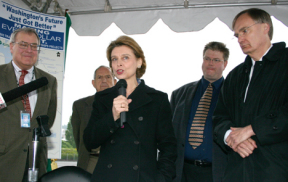Washington State Governor Christine Gregoire yesterday signed House Bill 1181, allowing the completion of the Heavy Haul Industrial Corridor within the Port of Tacoma area.
With her signature, Gov. Gregoire solved a dilemma faced by companies that “transload” cargo from rail boxcars into sealed ocean-going containers. The containers are then hauled by truck to marine terminals. Because of this transload process, vehicle weight sometimes exceeds legal axle weight restrictions. Through a permitting process, the bill allows transloaders to legally transport this cargo on designated roads in the Port area.
“The completion of this Corridor helps ensure the success of many companies that do business here in the Port area,” said R. Ted Bottiger, President of the Port of Tacoma Commission. “This, in turn, will not only preserve hundreds of family wage jobs here in the Tacoma-Pierce County region, it will help create more jobs as our Port continues to grow.”
The need for the Corridor, said Timothy J. Farrell, the Port’s Executive Director, can be illustrated by a common scenario of frozen poultry arriving in the Port area by rail. In Tacoma, cargo is transloaded from rail into a container and is then hauled a short distance by truck to a marine terminal for export. “Because of how these shipments originate, their strict requirements for documentation, and how they are configured for rail and steamship transport, shipment weight occasionally exceeds the vehicle specifications,” Farrell explained.
Through a permitting process for the Heavy Haul Industrial Corridor, Farrell said that qualified loads can be legally transported from the transloader to a marine terminal generally, a distance of less than two miles.
Governor Gregoire noted that the benefits of the Heavy Haul Industrial Corridor extend beyond the Tacoma-Pierce County region. “This will help companies throughout our state move their goods more efficiently, helping Washington companies compete more effectively in the international market.”
According Farrell, a coalition of stakeholders, including local transloading, warehousing and trucking companies, Washington State Patrol, Washington Department of Transportation, City of Tacoma and Port of Tacoma, met regularly over the past three years to establish Tacoma’s Heavy Haul Industrial Corridor.
“Across the board, there is widespread support for this project,” Farrell said, “but the Corridor would not have come to fruition without the leadership of Governor Gregoire and Representative Dennis Flannigan of Tacoma.”
House Bill 1181 completes the existing Corridor with the addition of State Route 509, which connects several segments of City of Tacoma roadways, already a part of the Corridor.
The Port of Tacoma Heavy Haul Industrial Corridor now encompasses:
- SR 509, from Taylor Way to East D Street;
- Taylor Way and a portion of Alexander Avenue, from TOTE Terminal to SR 509;
- Port of Tacoma Road;
- Marshall Avenue;
- Lincoln Avenue;
- Milwaukee Way;
- East 11th Street, from Port of Tacoma Road to Milwaukee Way;
- Portland Avenue, from Lincoln Avenue to East 11th Street;
- Portions of East D Street and East 15th Street.
Companies that wish to obtain a permit application for the Heavy Haul Industrial Corridor should contact the Washington State Department of Transportation.
Gregoires visit to Tacoma was one stop on a tour of Pierce, Snohomish, and King Counties yesterday, culminating in the signing of an $8.5 billion state transportation budget. According to the Governors Office, the budget will bring $769 million to Pierce County to create jobs, make roads safer and guarantee that local products can be shipped to markets around the world.
Gregoire highlighted these examples of planned transportation improvements in specific areas:
- HOV lanes on SR 167 from Auburn to Pierce County;
- New freeway between SR 509 and I-5;
- Replacement of the SR 162 Puyallup River Bridge;
- HOV lanes at I-5/SR 16 to improve capacity and reduce the risk of collisions;
- Construct and upgrade tracks along a 20-mile corridor for passenger train service, reducing the Seattle-Portland schedule by six minutes.
“To the people of Pierce County, who are worried about their jobs and their safety on our roads, I say the future just got better,” said Gregoire.








